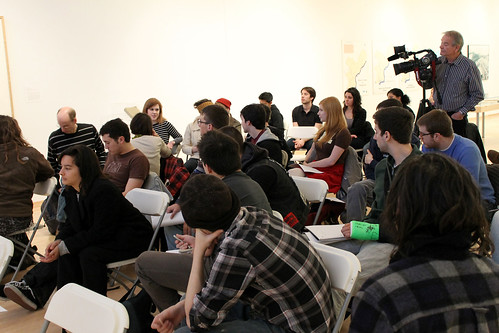
A teach-in created a dialogue about old and new protests at Temple.
Yellowed pages of old yearbooks and newspaper clippings papered the walls as curious students filed through the Temple Gallery in Tyler School of Art on Friday, Feb. 17, for a collaborative teach-in on the protest history of Temple.
With documents ranging from as far back as the 1960s and continuing all the way up to present-day footage of the Occupy movement, students were treated to a comprehensive look at the historic activism of the Temple community.
“There are all these layers of protest history in the university,” said architecture professor Alicia Imperiale, who has been compiling research as far back as 1968 on the subject. “That part of our history is crucial.”
Dr. Mary Stricker of the sociology department shared her firsthand experience with Temple protests.
As a graduate student in the ‘90s, Stricker was involved in the protesting of then-President Peter Liacouras’ Strategic Initiative, which heightened admission standards at the university. This initiative, while intended to boost Temple’s academics, outraged some members of the student body, who felt the initiatives had racial undertones, Stricker said.
This historic look into Temple’s protesting history was followed by an animated discussion led by members of Occupy Temple, a student group that grew out of the city’s local branch of the national Occupy movement.
Occupy Temple is a collection of students who congregate to share ideas and support shared causes, including student loan debt and environmental issues. The group has no leader, as members explained each person has the ability and right to speak for themselves.
Brianne Murphy, an Occupy Temple member and senior religion and visual anthropology major, spoke to her peers about the importance of public protest, and that inexperience was irrelevant when it came to involvement.
“I don’t know anything about organization, I don’t know much about protesting or recruiting and canvassing and all this stuff,” Murphy said. “[Protesting] is a way you can have a clear visual representation of an agency, and the ability to self-empower. You don’t need to go to school for protesting.”
Amidst recounts of group involvement in the Occupy Philly eviction and mountaintop removal coal mining protests, animated debate was sparked among participants and presenters alike.
Michael Chau, a recent transfer student, questioned the left-leaning tenets of the Occupy movement, and challenged group members to think about the wider appeal they could have if they lessened “extremist” views.
“The rhetoric, I guess, is sometimes off-putting,” Chau said to the packed gallery.
Tyler Student Larkin Dugan shared these sentiments, and added to the passionate debate among students and faculty. To Dugan, the Occupy movement doesn’t have enough focus, and is diluted by the wide variety of issues it protests.
“Ultimately, I don’t agree with everything that they say,” Dugan said. “I think that there is too much going on, they have too many points on their agenda.”
“It’s alienating. When you have a million people in a room, and every one of them is yelling their agenda, you wind up with a million points,” Dugan added. “But mostly it’s just a lot of people yelling.”
While lively discussion and debate was the order of the teach-in, students were encouraged to share their opinions freely, and to engage in conversation with a variety of different opinions.
For Professor Ralph Young, the organizer of the weekly teach-ins, the continuing dialogue captured the true essence of the events’ purpose.
“I don’t like to get involved, it’s up to you guys to do the discussing,” Young said. “I don’t want it to be a Q-and-A kind of thing. I want it to be dialogue. I just love Temple students – how intelligent and concerned and sensitive they are when they get into these things. It’s wonderful.”
Ali Watkins can be reached at allison.watkins@temple.edu.



Be the first to comment